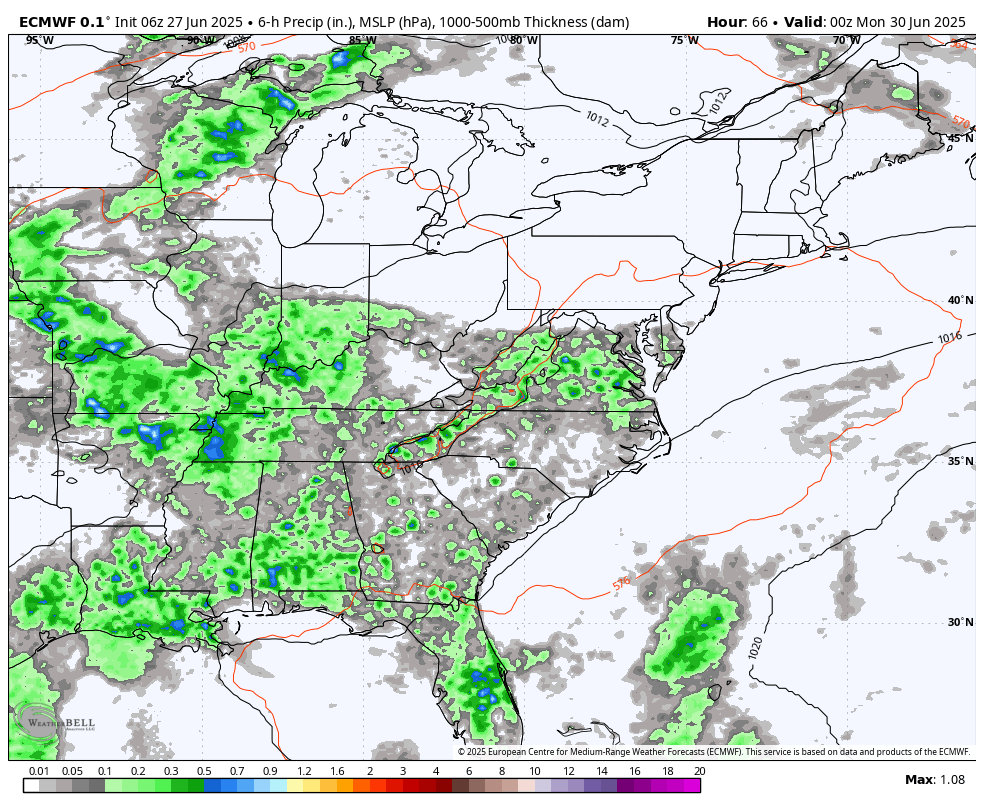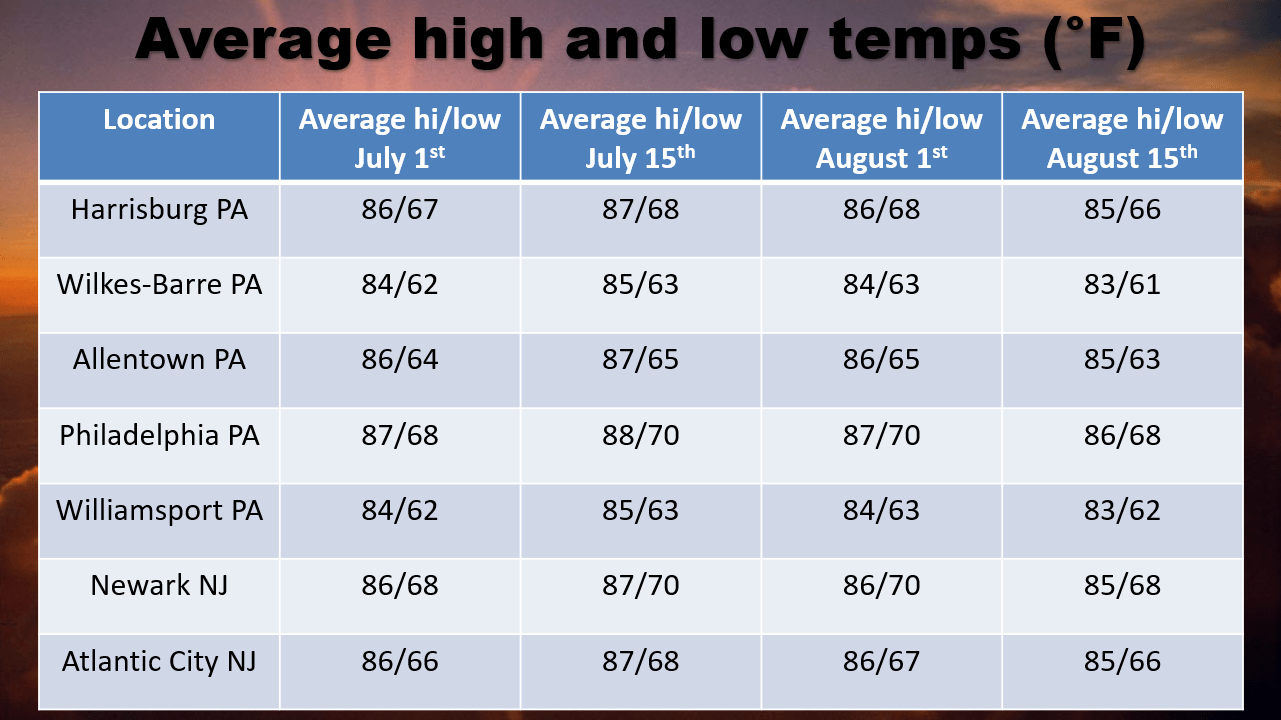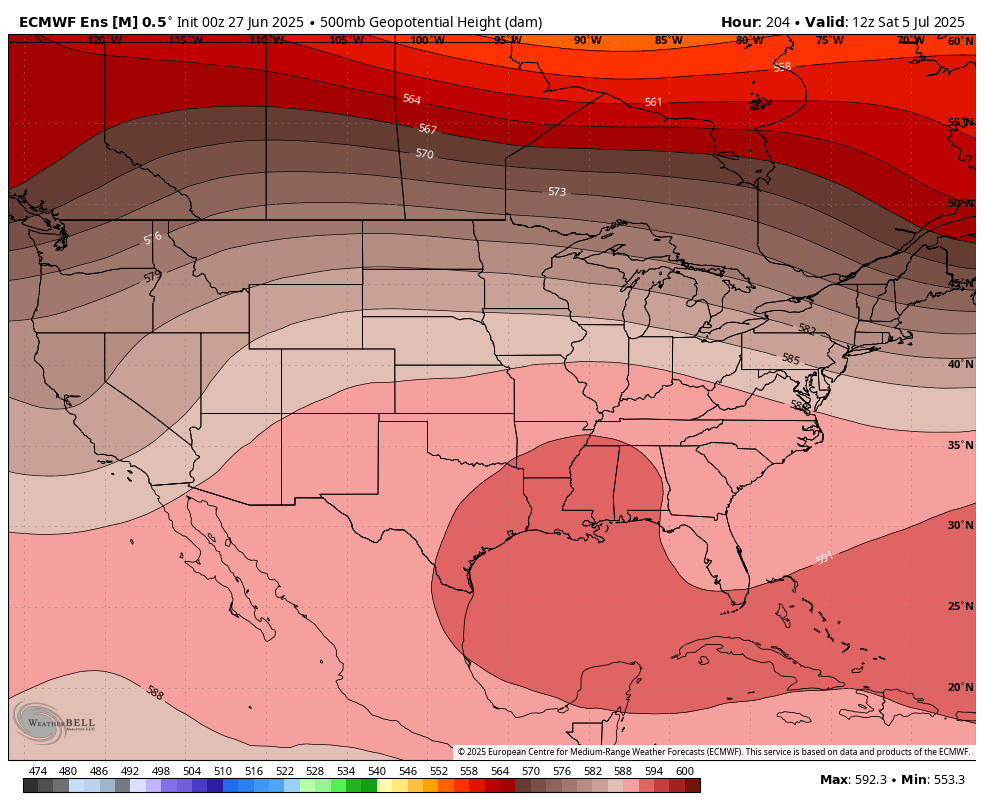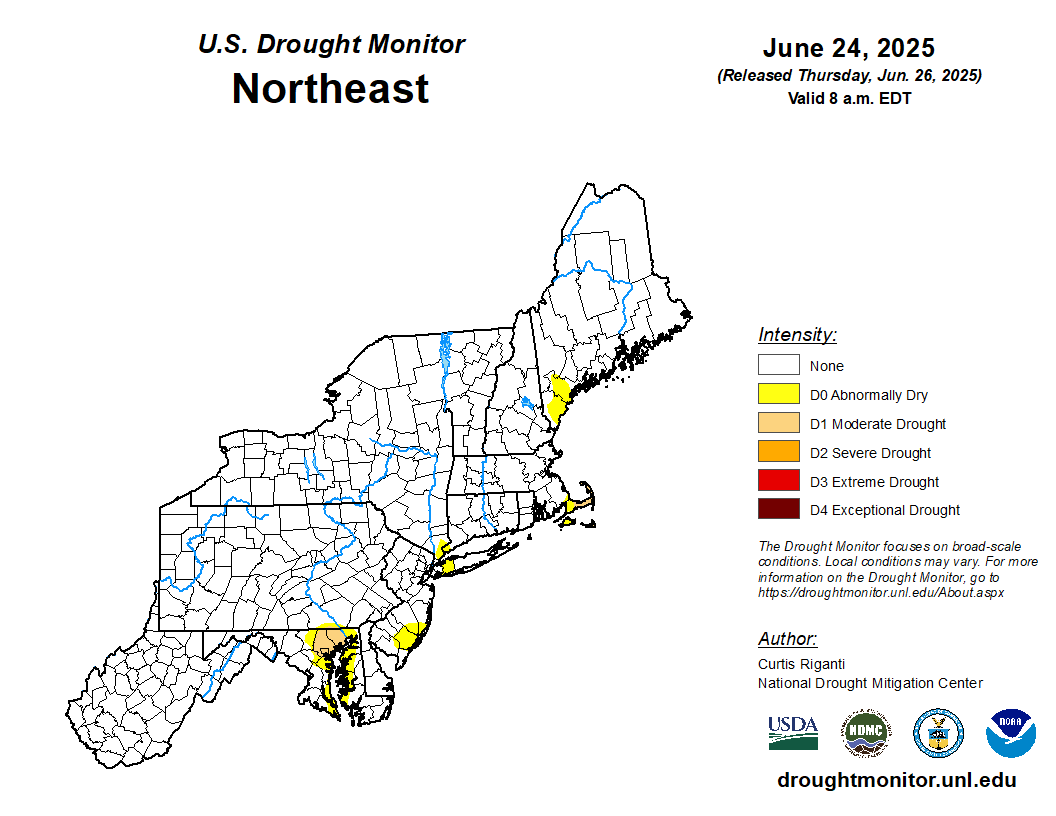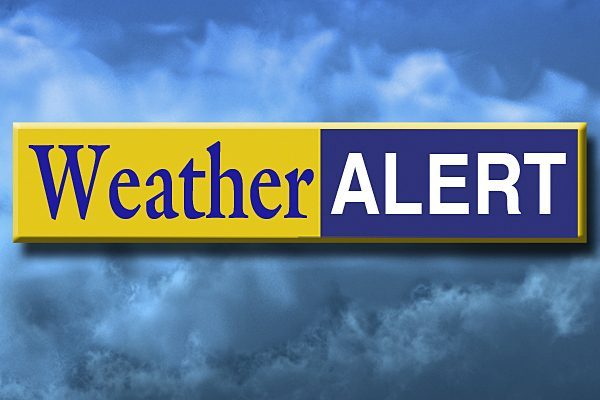EPAWA's Long Range Outlook
EPAWA's long range outlook is updated weekly every Friday morning before noon
Long range outlook most recently updated Friday June 27th, 10:00 AM
Technical discussion is below for advanced readers:
Technical discussion below will feature two (2) subcategories: Precipitation, and Pattern Discussion. Storm possibilities will be discussed exclusively in the Premium Forum with intense model analysis leading up to any major snow, ice, or rain events, not publicly. To join this discussion and hear the updated thoughts from our team, visit The My Pocket Meteorologist Page by clicking HERE and select the "Premium Weather Forum" option.
Precipitation Discussion
OVERVIEW: The US drought monitor (photo toward the bottom of this outlook) maintains NO drought areas within our Pennsylvania, New Jersey, or Delaware locales. One moderate drought area remains over Baltimore and Harford Counties in Maryland, otherwise much of Maryland has also improved significantly. This is largely due to quite an impressive month of May with a top 5 rainfall month all-time in some locations, and generally near average precipitation continuing thus far in June. We expect June will finish with a near average (-0.5" to +0.5") precipitation departure for the month as a whole as a composite regional average. The month of July projections were maintained this week for a near to slightly above average (+0.0" to +1.0") precipitation departure for the month as a whole. August monthly projections will be included in next week's outlook.
Shorter term, a backdoor cold front is influencing the region Friday, and that front will lift northward through our region overnight as a warm front. This will warm temperatures considerably over the weekend on the opposite side of the warm front, and will quickly be followed by a weak cold front late Saturday. A few late day or evening scattered thunderstorms will be possible Saturday with that front, then the front stalls to the south of the region Sunday. This stalled front will return northward as a warm front Monday, and is quickly followed by a cold front Tuesday. The early next week period will feature scattered showers and thunderstorms with both boundaries, then dry until late in the upcoming Independence Day holiday weekend.
June we expect to finish with a near average (-0.5" to +0.5") precipitation departure for the month as a whole, with scattered thunderstorm activity still possible June 28th and 30th. The month of July projections were maintained this week for a near to slightly above average (+0.0" to +1.0") precipitation departure, using longer term climate models as well as seasonal trends. August monthly projections will be included in next week's outlook.
Breakdown of precipitation departures from normal over the next several weeks:
June 28th - July 4th: Near to slightly above average
July 5th - July 11th: Slightly above average
July 12th - July 18th: Near to slightly above average
July 19th - July 25th: Near to slightly above average
July 26th - August 1st: Near to slightly above average
August 2nd - August 8th: Slightly above average
Public/free available maps will be updated when a threat is imminent for significant weather on the weather alerts page throughout the year: http://epawaweather.com/weather-alerts/
Note: Any image below is clickable for larger viewing
Pattern Discussion
OVERVIEW: The month of June projections are likely to finish with a near to slightly above average (0.0°F to +2.0°F) temperature departure for the month as a whole. The recent slightly increase in overall monthly temperatures is largely the result of strong upper-air ridging that affected the region within the past week with very high temperatures and warm nighttime lows. The month of July projections were maintained this week for another near to slightly above average (+0.0°F to +2.0°F) temperature departure for the month as a whole, using long term climate guidance and seasonal/global observation trends. August monthly projections will be included in next week's outlook.
- The overall pattern through at least mid-July will generally favor near to slightly warmer than average conditions for most of that stretch, and there continues to be indications that an overall wetter pattern will develop. This is likely to have an effect on temperatures, and limits the extended heatwave chances except on a shorter-term and transient basis. The near to slightly above average projections are more about the warmer overnight lows than it will be about high temperature extremes during the day. During the 2nd week of July, the expectation is for this upper-air ridging to retreat even farther SW to the 4 corners region (UT/CO/AZ/NM) which will place our area in a NW flow aloft... and keeps temperatures closer to seasonal average in this configuration with increased precipitation chances.
- The Madden-Julian Oscillation (MJO) is currently in the Circle of Death (COD) or NULL phase, and is largely expected to remain in the COD through at least late July. Since tropical forcing is weak, it becomes a non-factor in driving the pattern. Other forces like ridge placement will be key to our temperature patterns, and ridge position suggests near to slightly above average conditions in most cases through mid-July. The aforementioned ridging retreating to the SW US during week 2 July may lead to a stagnant NW flow aloft locally and a temperate pattern overall.
- A composite average of the SST departures in the ENSO regions places it in ENSO neutral territory as it has been for the past 2 months. The Niño 1+2 region (eastern Pacific near Peru) and Niño 4 region (Central Pacific) are the warmest of the 4 ENSO regions at +0.1°C, whereas the other regions (Niño 3 and 3.4) are near 0.0°C, placing the entire Pacific basin solidly in ENSO neutral territory. The expectation is for ENSO neutral to remain throughout the Summer months, which typically favors near to slightly above average temps in the June/July/August 3-month period. Near to leaning slightly above average precipitation is typical of June and July, with a historically wetter than average month of August during ENSO neutral Summers within the past decade.
Average high temperatures are currently in the 83-86 °F range from north to south across our coverage region, which is about 1-2°F higher than at this point last week. Average high and low temperatures will slightly increase incrementally over the next two weeks, and then peaks and reaches annual climatological maximums by mid-July. Any above or below average stretches listed in the outlook will be relative to seasonal norms at that time, and it is important to note that cooler/warmer periods will be relative to the time of year we are talking about. For example, the slightly above average temperatures listed for the June 29th-30th period generally features highs on either side of 90 degrees, coming at a time when average highs are typically in the mid-80s. Use the average highs/lows chart below providing a point of reference and transparency for what average temperatures are at each corresponding location through August 15th.
The month of June projections were maintained this week for a near to slightly above average (0.0°F to +2.0°F) temperature departure for the month as a whole, and July projections were also maintained this week for a near to slightly above average (0.0°F to +2.0°F) temperature departure for the month as a whole, using long term climate guidance and seasonal/global observation trends. August monthly projections will be included in next week's outlook.
Note: Any image below is clickable for larger viewing
Long Range Outlook Table
| Date(s) | Threats | Significance | Confidence |
| 6/28 | Temperature | Near average | Very high |
| 6/29-6/30 | Temperature | Slightly above average | Very high |
| 7/1-7/5 | Temperature | Near average | High |
| 7/6-7/12 | Temperature | Near to slightly above average | Moderately high |
| 7/13-7/20 | Temperature | Near average | Moderate |
| 7/21-7/27 | Temperature | Near to slightly above average | Moderately low |
| 7/28-8/3 | Temperature | Near to slightly above average | Low |
| 8/4-8/10 | Temperature | Near average | Very low |
| 6/28 | Weak cold front | A weak cold front crosses the region late Saturday with a few thunderstorms possible late afternoon and evening, but most of the day is completely dry | High |
| 6/30-7/1 | Warm and cold fronts | Saturday's weak front stalls south of the region Sunday, and returns northward as a warm front late Monday, and will be immediately followed by a cold front Tuesday with scattered showers and t-storms | Moderately high |
| 7/6 | Cold front | A cold front will cross the region late in the holiday weekend with scattered showers and t-storms | Moderate |
| June as a whole | Temperature | Near to slightly above average (+0.0°F to +2.0°F) | Very high |
| June as a whole | Precipitation | Near average (-0.5" to +0.5") | Very high |
| July as a whole | Temperature | Near to slightly above average (+0.0°F to +2.0°F) | Moderately high |
| July as a whole | Precipitation | Near to slightly above average (0.0" to +1.0") | Moderate |
Long range outlook table last updated: Friday June 27th, 10:00 AM. Next scheduled update: Thursday 7/3.
This is a weekly updated public long range guidance product from EPAWA. For daily long range updates and more detailed updates M-F, please join the EPAWA forum.
More information/sign-up at: http://epawaweather.com/mpm/
Climatology
*Indications of above or below average temperatures in the table above are relative to what is considered "normal" using data collected over the long term for a particular date. This is collected and maintained by the National Climatic Data Center in conjunction with the National Weather Service actual data from previous years collected at official ASOS/climatology stations across our coverage area. Also note that as time moves forward into a different period as shown above, average temperatures for those dates will also change. See the example below using Philadelphia, PA as the climate station, which represents out projections on that precise date listed:
| Date | Average Hi/Lo (°F) | Current EPAWA projection |
| June 28th | 87°F/68°F | Near average |
| July 5th | 88°F/69°F | Near average |
| July 12th | 88°F/70°F | Near to slightly above average |
| July 19th | 88°F/70°F | Near average |
| July 26th | 88°F/70°F | Near to slightly above average |
| August 2nd | 87°F/70°F | Near to slightly above average |
| August 9th | 87°F/69°F | Near average |
The departure from normal uses the average temperature for the date, averaging temps over 24 hours for any given location, using both high and low temperatures hourly during any particular day. This outlook determines warm vs. cool periods relative to normal temperatures.
Climate Prediction Center (CPC) Graphical Products
These products are from the NOAA Climate Prediction Center (CPC) and do not necessarily reflect the EPAWA forecast which is detailed above. All images below update automatically as the CPC releases new graphical products
U.S. Soil Moisture Anomaly
US drought monitor (NE US)
Forecaster: EPAWA Meteorologist Bobby Martrich
Discussion last updated: Friday June 27th, 2025 10:00 AM



